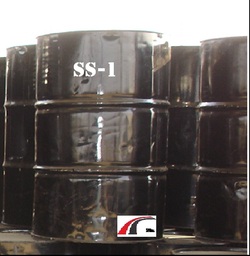
Ss 1h asphalt emulsion manuals#
More detailed information on care and handling of emulsions is available in manuals available from the Asphalt Institute. Standardized emulsion tests are documented in ASTM D 244 and AASHTO T 59. Some emulsion tests are intended to measure composition, consistency, and stability other tests on the asphalt residue predict performance in service.

Contamination and/or premature breaking are specific concerns for emulsion samples. Experienced, knowledgeable personnel should take samples. Obtaining representative samples of emulsions is critical.

As with any material, accurate test results are dependent on proper sampling and handling techniques.Medium sets and slow sets can be diluted by slowly adding water to the emulsion. Avoid mixing different classes, types and grades of emulsions in storage tanks, haul transports or distributors.Use gentle, slow-speed circulation techniques. Storage tanks should be insulated to reduce heating costs and to guard against freezing. Some grades have more specific storage limits. Store most emulsions between 50 and 185❿.Some important handling guidelines include: Emulsions have particular storage and handling requirements. The asphalt is sheared into tiny droplets (1 to 10 microns, smaller than a human hair) and blended with the other components. “HF” or high float emulsions use a gel structure to allow a thicker asphalt film.Įmulsions are made in specialized plants, usually including a colloid mill. An “h” indicates harder base asphalt was used (SS-1h). A “2” (for example, RS-2) is more viscous than a “1”(RS-1). Numbers in an emulsion’s classification refer to the viscosity of the emulsion. Polymers are added to enhance strength, adhesion and durability. The addition of “P” in the emulsion classification indicates polymer has been added to the emulsion. QS emulsions are designed for use in micro-surfacing and slurry seals when a quick curing time is needed for opening to traffic. They are the most stable emulsions and are used for tack or bond coats, fog sealing as well as in slurry seals and some asphalt surface courses. SS emulsions are designed for maximum mixing time and workability. MS emulsions are used in making cold mixes and in cold recycling applications. MS emulsions are designed to be mixed with graded aggregates. RS emulsions break rapidly and are typically used for spray applications, such as chip seals and sand seals. The standardized designations are RS for rapid set, MS (medium set), SS (slow set) and QS (quick set). Setting is closely related to how soon an emulsion breaks. There are a few nonionic emulsions, but they are not widely used.Īfter the charge designation in an emulsion classification, there is information about the “setting” rate. Cationic (positively charged) emulsions are identified with a “C.” If the C is not included, the emulsion is normally anionic, negatively charged. (Most highway agencies have adopted these standards, but there are some local and/or proprietary designations.) The first designation is based on electrical charge. The American Society for Testing and Materials (ASTM) and the American Association of State Highway and Transportation Officials (AASHTO) have standardized how emulsions are identified. After breaking and curing, the asphalt residue has the adhesion, durability and water-resistance properties of the original base asphalt. Breaking is the separation of the water from the asphalt. An emulsion should “break” quickly upon contact with aggregate when mixed or after being sprayed. An asphalt emulsion consists of three basic components, asphalt, water and an emulsifying agent.Īn asphalt emulsion is a stable dispersion of asphalt cement droplets in water, which can be pumped, stored and mixed with aggregates. The Asphalt Institute?s manual, “MS-26 -The Asphalt Binder Handbook,” defines emulsification as “a process through the use of certain mechanical and chemical processes, that allows two or more materials to combine that will not mix under normal conditions.”Įmulsions are very common materials ice cream is an example. And there is another major category of asphalt applications - those including the use of asphalt emulsions.

Asphalt is used in hot mixes and now warm mixes. It is widely used in pavements to bind and waterproof aggregate mixtures and to seal surfaces. Asphalt is one of the more commonly used construction materials.


 0 kommentar(er)
0 kommentar(er)
